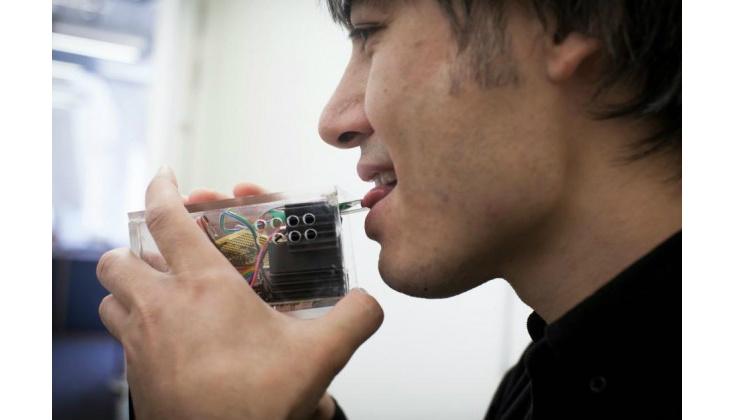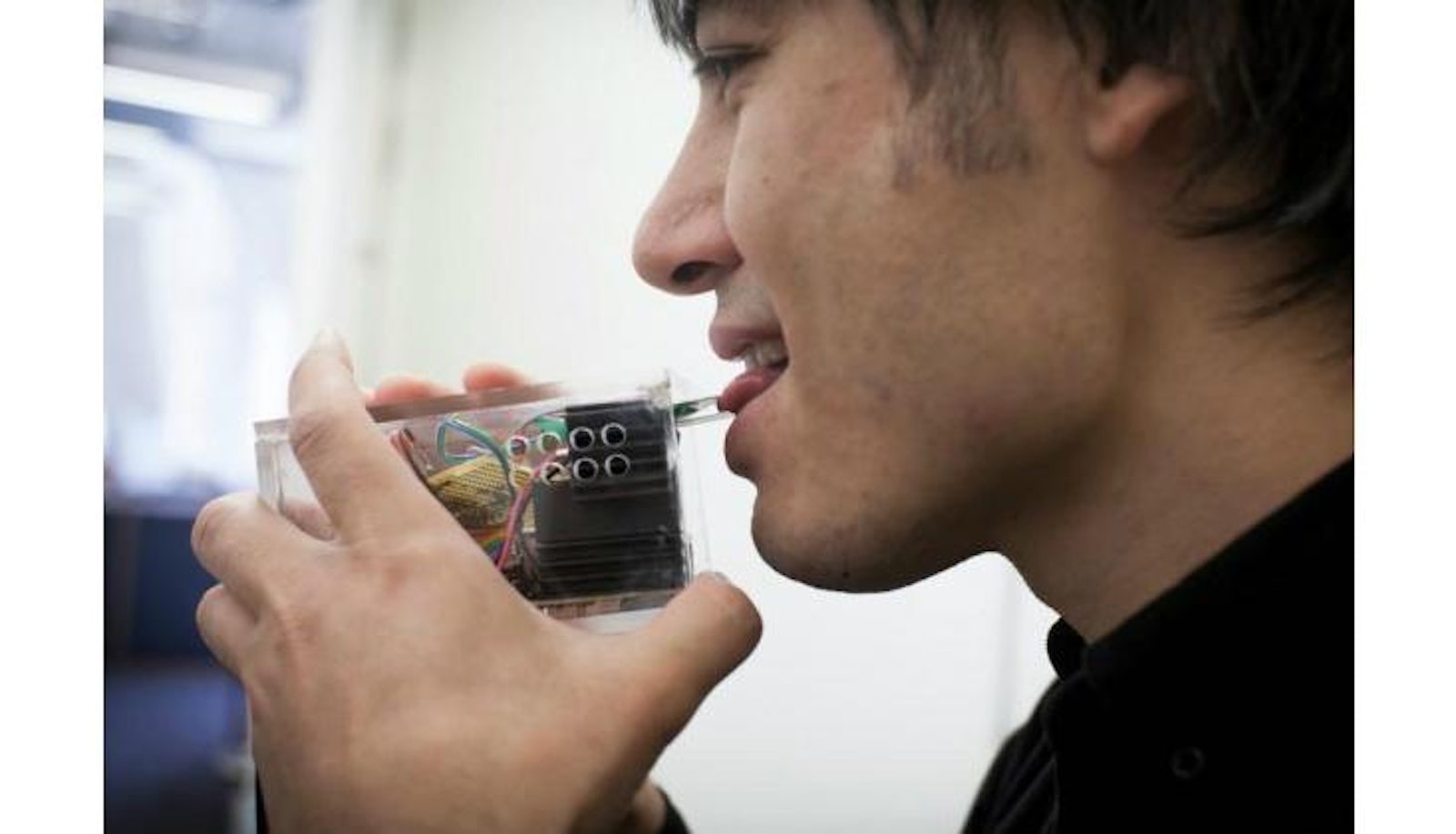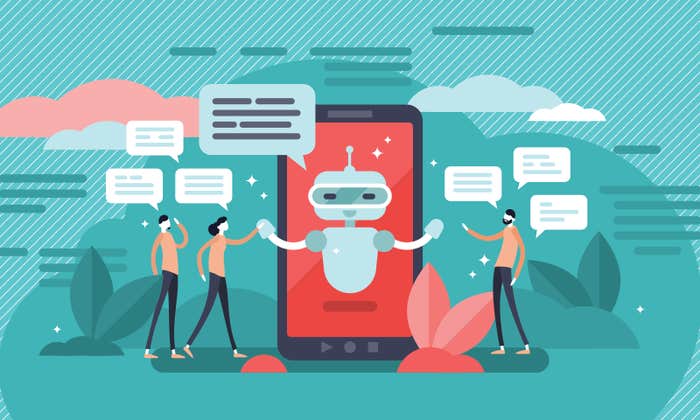Of all of the wondrous feats accomplished by Willy Wonka in his candy factory, the most impressive may have been wedging an entire meal into just one unassuming stick of gum: Upon popping it in your mouth and chewing, you’d first taste tomato soup, then roast beef and baked potato, and finally blueberry pie and cream. This trick seems purely fantastic, but what if a device could really deliver experiences like that? Imagine a gizmo that can bring back the smell and taste of meals long gone, like a beloved grandmother’s drop cookies, the first bite of one’s wedding cake, or the aroma of baked shad from a fishing tradition now seldom practiced. Imagine all of your scents and tastes stored as files alongside music and movies in the digital cloud, ready for re-experience or sharing with friends across social media.
According to one electrical engineer committed to elevating human digital communication, this extension of our digital life is closer to download than you might think. Adrian David Cheok, the founder and director of the Mixed Reality Lab in Singapore, and a professor of pervasive computing at City University London, has long been interested in finding new ways to connect the real world to the virtual world. In 2008 his team developed a remote-controlled hugging pajama, transmitting touch via wifi. Last year, Cheok worked with engineer Nimesha Ranasinghe to produce a “digital lollipop,” a system designed to elicit sensations like sour and sweet by electrically stimulating taste buds. (The effectiveness of the device has not yet been established in a peer-reviewed publication.) Now Cheok is tackling the perception of smell by using magnetic coils to directly stimulate the olfactory bulbs, the seat of scent perception in the brain. Cheok’s goal is to induce smell without the use of chemicals, a feat that has never been done before. And since scent is a prominent part of flavor, a tool that can stimulate scent in the brain could also help recreate better virtual versions of food.
But the task of inducing specific smells, and then flavors, promises to be a hugely difficult one. Of all the human senses, Cheok acknowledges that smell is probably the trickiest to duplicate digitally. The technical challenges Cheok faces show how hard it would be for any would-be Wonka to flip a switch and flood your mind with that perception of grandma’s cookies—and how far off that moment probably is.
“When you’re not tuned to any particular radio station, you hear a kind of noise—audio noise. We actually don’t know what is the equivalent of audio noise for smell.”
Sitting in a big-screen theater with the latest projection and sound equipment, watching a movie shot, edited, and projected with digital gear, you might get the feeling that today’s technology can recreate practically any sensory info. Audio and video, however, are the low-hanging fruit of the sensory world. Sound and light are both types of waves that can be easily generated by machines. Change the shape, size, and frequency of the waves, and you can control what someone sees or hears. But smell involves detecting actual chemicals, with hundreds of different kinds of sensors on the ends of nerve cells. Those sensors can be stimulated in a dizzying number of combinations to transmit particular scents to the olfactory bulbs, and then to other perceptual-interpretation areas of the brain. “You have 450 receptors…and each receptor cell expresses only one type of receptor,” says Richard Doty, director of the Smell and Taste Center of the University of Pennsylvania. “Any smell is some combination of those various inputs. Banana oil will stimulate a dozen different receptor types, while rose might stimulate some [others] that are unique.” To get the smell of banana right, you’d presumably have to stimulate the olfactory bulbs in a way that corresponds to how the cell receptors have been triggered by banana odorant molecules. It’s a specific combination of inputs, and it has to be stimulated in exactly the right way in order for a person to perceive the banana’s distinctive odor.
Cheok’s experiments are underway, testing human response to olfactory bulb stimulation, but there is currently no way to trigger that part of the brain so precisely. Doty lays out the big obstacles to digitally recreating smell, and taste: “You can do transcranial magnetic stimulation, but that’s pretty gross [imprecise]. With olfactory, you can’t stimulate accurately. The problem would be that you’d have to have signals that are very precise. You can stimulate the olfactory bulb theoretically, but the bulb has all kinds of inter-neurons and structures designed to modulate information from the receptor cells.”
The task of inducing scents with wires and circuit boards gets even more complicated when human emotion is tossed into the equation. Emotion and memory are tightly intertwined with scents and flavors. While our vision is hooked up to the frontal cortex, where logic often holds sway, smell is connected directly to the subconscious part of our brain. The perceived smell of one wine, for example, can vary depending on context. Fancy gala? Expensive, complex wine. Same wine, neighborhood corner store, $12? Pretty good for 12 bucks. “Taste and smell are the two senses which are connected to the limbic system of the brain—[a system] also responsible for emotion and memory,” says Cheok. “Smell can directly trigger a memory, subconsciously trigger emotion. Some smells are difficult to determine, and also, they change with context.”

Still, Cheok is working on a device to overcome these hurdles. It will look like a mouthguard or retainer, a rechargeable, wireless, battery-powered, microprocessor-controlled machine sitting up against the top of one’s mouth. Inside the mouthpiece will be a number of tiny magnetic coils that can emit controlled magnetic fields that reach up across the palatine bone at the top of the mouth, past the receptor cells ready to grasp any wafting odoriferous chemicals, and into the two knobby, blueberry-sized olfactory bulbs.
The group is working with Olivier Oullier, who studies the brain at Aix-Marseille University, to figure out how the brain needs to be stimulated in order to induce, for example, the scent of vanilla, or of banana. Because no group has done this before, Cheok and his colleagues will initially just feel out the effects of varying frequency on the olfactory bulb. They’ll transmit varying signals, while measuring the responses with fMRI scans in humans. Cheok says they first may see something like noise. “When you’re listening to the radio and you’re not tuned to any particular radio station, you hear a kind of noise—audio noise. We actually don’t know what is the equivalent of audio noise for smell—white noise of smell.”
Because of the emotional component of scent perception, Cheok isn’t yet sure how specific induced smells can be. The plan is to record an fMRI signature of a person smelling familiar scents, like coffee, chocolate, or banana. Because they’re so familiar, Cheok says they don’t really depend on context. Once fMRI signature scans have been recorded, Cheok plans to create a catalog of the thousands of different smells we can identify. “Before the CD, music was analog. If you wanted to distribute music, you had to share cassette tapes. You can’t share millions of tapes very easily. But once it became digitized, it became easily transmitted, and that’s what we have to do with smell.”
“Even if we had knowledge of the number of receptors involved with a particular odorant, it’s in a patch of tissue only about a few centimeters in size. And we have 10 million cells in there.”
There is a long road ahead for Cheok and anyone else trying to create digital smells. After testing magnetic stimulation of the olfactory bulbs, his group needs to map the area in exquisite detail, and pinpoint where and how signals should be directed. Then comes brain scans of people smelling things like banana and chocolate, at precision not yet available, and the cataloging of scents. Then a great deal of testing for safety and efficacy across individuals with differently wired brains. It will likely take decades if it works at all. Authorities within the field, like Doty, say the olfactory system is still largely unknown territory. “Even if we had knowledge of the number of receptors involved with a particular odorant, it’s in a patch of tissue only about a few centimeters in size. And we have 10 million cells in there,” he says. “Sounds like a longshot, but there are a lot of things that come along that are before their time.”
Cheok isn’t deterred by great uncertainty of how well his approach works or the long timeline of the project. After all, he says, “sometimes these things can take a very long time. If you look at something like the iPad, tablet computing was actually invented in the 1970s, the early 1980s, at the Xerox PARC lab. Alan Kay came out with the prototype tablet computer in the late 1970s. But it really took, 30, 40 years for the iPad to come out. But I think that doesn’t mean we should stop doing research, because if we don’t do this in the lab, then we won’t get these technologies.”
Ultimately the sheer desire to have such an amazing device may be enough to get researchers through this long process. There’s no doubt we are fascinated by smell and taste; the dream of controlling those senses with an app may simply be too compelling to ignore. “People watch the cooking shows and there are famous chefs on TV showing their recipes,” says Cheok. “But wouldn’t it be great to taste and smell while you’re watching it on TV?”
Yvonne Bang is an assistant editor/video production manager at Nautilus.




























